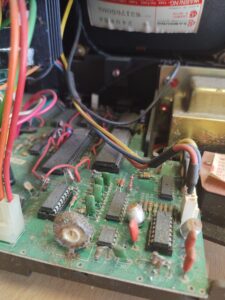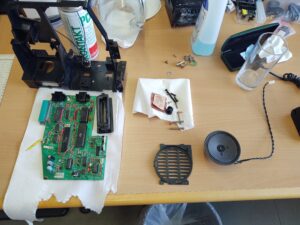![]()
 It was some time ago that I edited and prepared this darling. Writing a post about it is a completely different topic. I have often thought to myself that one could film the repairs and preparations right away and then make a small film out of them and publish it on a video platform … Well, at least now, in the meanwhile second Corona Lock down and a sleepless night, I am sitting in front of the computer again and try to write a few lines about this piece of ingenious hardware. I have never owned this “ingenious piece of hardware” myself and found out about its existence late, but when I had read a little bit, I had to have one – but of course at an affordable price. As always, we searched for defective devices for a long time – and since they were only manufactured for a short time, they are also rare and difficult to find. But after a long search I was lucky and found a defective, but partly complete device. As already written above in the title, it is about the (or “the”) Vectrex.
It was some time ago that I edited and prepared this darling. Writing a post about it is a completely different topic. I have often thought to myself that one could film the repairs and preparations right away and then make a small film out of them and publish it on a video platform … Well, at least now, in the meanwhile second Corona Lock down and a sleepless night, I am sitting in front of the computer again and try to write a few lines about this piece of ingenious hardware. I have never owned this “ingenious piece of hardware” myself and found out about its existence late, but when I had read a little bit, I had to have one – but of course at an affordable price. As always, we searched for defective devices for a long time – and since they were only manufactured for a short time, they are also rare and difficult to find. But after a long search I was lucky and found a defective, but partly complete device. As already written above in the title, it is about the (or “the”) Vectrex.
The Vectrex is a home arcade machine, with a 24cm monochrome picture tube, a fold-out and also removable joystick. This slot machine is a complete “stand-alone” system that only needs a power supply from the socket and you can start right away. The game of the Vectrex is called “MINE STORM” and is a clone of the ASTEROID game. So at that time you bought an ASTEROIDS machine for your home. When I speak of “then”, it means from 1982 to 1984. Because the US company General Consumers Electronics (GCE) started selling the machine in 1982. At that time, however, Atari was already on the market with the 2600 and enjoyed great popularity. The sale of the C64 by Commodore was also imminent. These events reduced the chance of the Vectrex’s big breakthrough, especially since the starting price of $ 200 was not a bargain. The sales company GCE went bankrupt in 1984. In Europe, “MB” Milton Bradley was the rights holder from 1983 and sold the Vectrex (or which?). In order to not only have to play the integrated MINE STORM, there is an expansion port in which game modules in ROM form can be plugged. There was a manageable amount of game titles – by that I mean, there weren’t that many. I mentioned a few of them in the post “Homemade game module for the Vectrex”. But there is still a community today that deals with the hardware and software for the Vectrex and develops its own games (so-called homebrew games). On the website vectrex.de you can find a rich collection of information about the hardware. Youtubers like Zerobrain and Wolfgang Robel also deal with this topic and have published interesting articles on it.

So – but now to the technology of the console. The Vectrex consists of a black plastic housing. Built into it is a CRT (in German a cathode ray tube, i.e. picture tube) in portrait format. A board for controlling the tube with the high voltage generation and drivers for the deflection coils. Then there’s a 50 Hz mains transformer that serves as a low-voltage supply for all of the electronics. It should be noted here that the primary side of the transformer is connected directly to the mains cable as the 240VAC side. The transformer ALWAYS consumes energy. The combined volume / mains switch is attached to the low-voltage side and only separates the electronics. The transformer always remains connected to the network. So if you are not using the device, you should also pull the power plug.

To continue with the list of innards: What is still missing is the, well, not entirely unimportant part – the mainboard with the “computer”. A 6809 CPU from Motorola works on it. This is an 8-bit CPU that is driven with a clock rate of 1.6MHz. The clock is generated by the on-chip oscillator, which only needs the quartz in the outside world. As always, the exact technical features can be found in the data sheet. A three-channel synthesizer sound chip, the AY-3-8910, is installed to generate the sound. Unfortunately, savings were made in further signal processing and the audio signal has to take along almost all of the radiated interference on the way to the audio amplifier that the power levels emit to control the picture tube. But that is a well-known phenomenon. The Vectrex is known for the “I call it” messy, noisy sound output. But this also shows the originality of the early consoles. Allegedly the last generations should not have this problem anymore before the end of the sale. So far I have only got to know the noisy Vectrexes.
From sound to picture. And that’s also one of the big differences from traditional video game consoles. A conventional game console as well as any television receiver rasterizes the image. The electron beam of the tube means that the image information is written line by line onto the luminous layer. Depending on the standard, there are differences here, such as field processes or the number of lines or the number of image changes. But the principle is the same for all raster writers. At the top left, you begin to write a line with the different brightness and color information. Then the beam reaches the right end of the picture edge and is switched to dark in order to start again very quickly in the next or (depending on the method) the next but one line. With the PAL system the time from left to right was 64µs and that with 625 lines. That means a complete picture was written in 0.04s. This in turn means that in one second you can achieve a number of 25 displayed images:
64µs per line * 625 lines = 0.04s per image * 25 images = 1 second
So far so good. The electron beam was deflected by means of magnetic fields via coils on the neck of the picture tube.
It works a little differently with the Vectrex. The name Vectrex, according to my approach, comes from the term “vector” by definition: size that is represented as an arrow running in a certain direction with a certain length and which can be determined by various information (direction, amount). In the data sheet of the Vectrex one reads with a screen resolution of 256×256 positions. This means that, starting from its zero position (i.e. both deflection coils do not generate a magnetic field), the electron beam can be deflected in 128 steps up, down, left and right. (both axes each have a resolution of 8 bits). How does it work now? Let us assume that a small triangle is to be displayed in the upper left area of the screen. We assume that the left edge of the image is at x = -128, the right at x = + 128, the upper at y = -128 and the lower at y = + 128.

For this purpose, the electron beam is deflected from its zero position to the top left, for example in x = -50 and y = -50. From there it drives to the next point of the triangle e.g. -40 / -60 and from there to the next (e.g. -30 / -50) and then back again to -50 / -50. While approaching these three points, the electron beam is switched to light. So he draws the triangle. From the last point and also the first point of the closed triangle, it goes back to the zero position and of course with the electron beam switched to dark. As long as the triangle is displayed on the screen, the process is repeated at maximum speed in order to see a nice, flicker-free triangle. Now you can imagine what happens if a lot of symbols are to be drawn at the same time. Of course that is not possible. The beam must approach and draw all symbols one after the other. This means, in turn, the more symbols, the longer it takes until the image is completely drawn and, conversely, the slower the refresh rate. So the more graphic symbols, the more flicker.
The X / Y data are generated digitally as 8-bit values and converted into an analog voltage via two 8-bit DA converters (digital / analog). This voltage is adapted to the non-linear behavior of the deflection electronics (using OP-amp integrators) and fed to a two-channel amplifier stage, which also creates frequencies in the higher kilohertz range and is able to drive the deflection coils, i.e. inductive loads. And what is available here: An audio output stage from an audio amplifier. And that’s exactly how it was solved here. Under the heat sink is a LM379 dual 6W audio amplifier IC from National Semiconductor. A nice detail on the side: The high-voltage transformer is IC-clocked by an NE555 …
In order to be able to operate the games on the Vectrex, a removable controller – i.e. joystick – is integrated with four buttons in the form of the lower front cover. The two-axis stick consists of two potentiometers with which a fine, “quasi stepless” control of the game objects is possible.
Well, and such a console, or Home Arcade, or just such a treasure, I found cheap after an endless search. With a few problems, of course. First and foremost, it was important to me that everything was complete and that no parts were missing if possible. From the outside, everything was there, except for a cut power cord. The controller was complete – the spiral connection cable was not missing either and was in good condition. Unfortunately, someone had already tinkered with the controller housing and tried to pry the two housing halves apart with a screwdriver, but apparently had not considered that there are a number of screws under the upper sticker that hold everything together. The case looks accordingly today. – Unfortunately-

Due to the accumulation of dust and the musty smell, the Vectrex had apparently spent the past 35 years in a cellar or attic. So my plan was to completely dismantle the whole device and check for completeness at the same time. As soon as I opened the case screws, I noticed that a couple of screws were missing. So there was already someone inside. After the complete dismantling, intensive cleaning was required. More precisely, it was more of a washing. So everything from the picture tube, the deflection unit to the boards had to go into the soap bath. After drying, the result can also be seen. The parts look like new again. Repairs could now begin.
In the end it turned out that apart from a few small things there were no major problems. At first the power switch was so resinous on the contacts that no closed contacts could be reached at both poles. Then there was no high voltage on the tube – here the transistor BU407 was defective and only switched through very tired or not at all. The various pots needed a little affection and one or the other capacitor still had to be replaced. But that’s about it. Below I upload a few pictures of the cleaning and repair work.



















